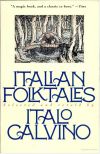"Wildwood King": A Hermit in Italo Calvino's Italian Folktales
 Writer Italo Calvino (1923-85) selected and
edited 200
representative folktales of Italy that echoed European folktales in
general. The work was published in 1956 and translated into English in
1980. Among the stories, the 111th is titled "The Wildwood
King," a tale ascribed to the Abruzzo region of southern Italy.
Writer Italo Calvino (1923-85) selected and
edited 200
representative folktales of Italy that echoed European folktales in
general. The work was published in 1956 and translated into English in
1980. Among the stories, the 111th is titled "The Wildwood
King," a tale ascribed to the Abruzzo region of southern Italy.
The Wildwood King is a forest hermit, but feared by association with werewolves and ogres, as will be seen.
The story is classic, reminiscent of Snow White in plot. A king has three daughters. The elder two are plain but the youngest is "beautiful beyond words." The king cannot marry off the elder daughter because every suitor who visits eyes only the youngest daughter. So the elder sisters scheme against the youngest. They tell their father of having identical dreams of their youngest sister eloping with a common soldier. Such a dishonor must be prevented, they insist, and the old king orders his general to take the girl to the forest and kill her.
Like Snow White, the girl is spared because the general cannot bring himself to slay her. He takes her cloak, soaks it in lamb's blood, and returns to the king to show him that the deed has been done.
Meanwhile, "the girl remained in the woods, weeping, terrified at the thought of the wildwood king who lived in those woods and ate everyone who crossed his path." Thus is the wildwood king already known by reputation as an ogre or werewolf or a "beast" in the manner of Jeanne-Marie LePrince de Beaumont's "Beast" in his famous "Beauty and the Beast," wherein the hapless Beast describes himself: "My heart is good, but still I am a monster."
The day concludes: "After crying for a while, she dried her eyes and fell asleep in a hollow tree trunk." Such hollowed tree trunks were called "goosepens" or equivalent in many cultures because people dwelling nearby would house their geese and other fowl in these hollows. Wild creatures from bats to bears might also inhabit such hollow trunks. More releventaly, perhaps, the tale may here allude to where the hermit in the French fairy tale "Princess Rossette" lived:
The queen heard that in a great forest near the castle there was an old hermit, who lived in a hollow tree, and that people came from far and near to consult him.
Next morning, the wildwood king was out hunting and came upon the sleeping princess. He kindly asks if she would like to go to his house, deep in the woods, "where he led a sad, solitary life, going out hunting and never seeing a living soul."
The medieval archetype of hermit would not hunt, indeed, would not eat flesh. Here, then, is another clue that the wildwood hermit is not a religious hermit, Christian or pagan. Yet, if not, his kindness is almost startling, and must have been so for the princess, though the narrative is muted, noting only that the girl began keeping house for him, and that "the old hermit loved her like a daughter."
One morning, braiding her hair at the open window of the forest cottage, the girl is visited by a parrot. The parrot alights on the ledge and warns the girl that the wildwood king is going to eat her. (Still another clue as to the nature of this king of the forest). Hearing this, the princess cries. When the hermit returns and asks why she is crying, the girl relates what the parrot has said. The hermit scoffs at the threat of the parrot and teaches the girl what to reply when the parrot returns to taunt her -- that he, the wildwood king, will eat the bird! It is a threat, but rings true to those in the forest who know him.
Next morning, the saucy parrot returns to repeat his taunt, but the girl is ready for him. She replies as the hermit told her, peeving the parrot so much that he shakes out half of his feathers before flying off. This scene is repeated for days in a row.
The parrot belonged to a neighboring king. Upon seeing the parrot half-plucked every day, the king asks his servant to explain. The servant explains of the parrot that "every morning he flies off in the direction of the wildwood king's house and comes home plucked." On horseback, the king follows the parrot into the woods and witnesses what happens. But the king falls in love with the beautiful princess.
Then that king went to the wildwood king and asked for the girl's hand in marriage. The wildwood king gladly gave her to him, although it grieved the old king to be separated from her. She thanked him and bid him farewell, leaving him by himself in the depths of the woods.
Among the guests at the wedding banquet was the bride's father, "who asked her forgiveness for all the suffering he had caused her at the prompting of the wicked sisters." The tale says nothing about the fate of those sisters but does inform us that the parrot "flew off and was never seen again."
Alas, we hear nothing further of the solitary wildwood king with the mixed feelings. Presumably, however, he too was never seen again.
¶
